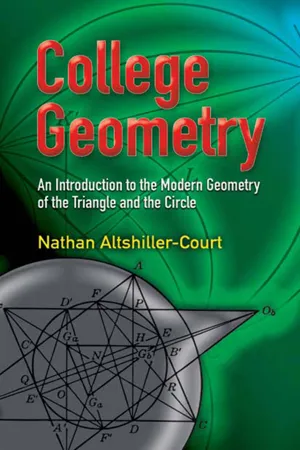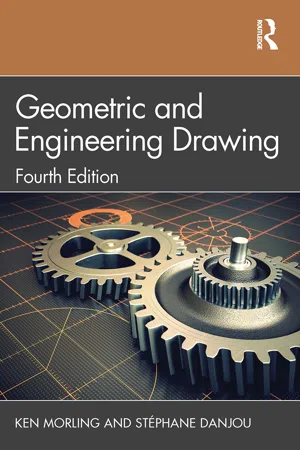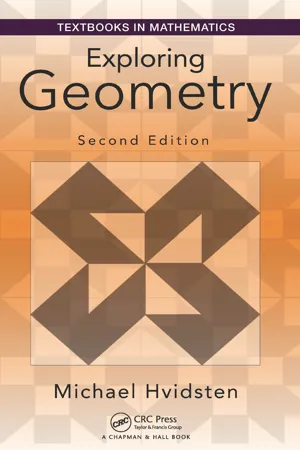Mathematics
Construction and Loci
Construction in mathematics refers to the process of creating geometric figures using only a compass and straightedge. Loci, on the other hand, refers to the set of all points that satisfy a given condition or set of conditions. Together, construction and loci are used to solve problems in geometry and other areas of mathematics.
Written by Perlego with AI-assistance
Related key terms
Related key terms
1 of 4
Related key terms
1 of 3
3 Key excerpts on "Construction and Loci"
- eBook - ePub
College Geometry
An Introduction to the Modern Geometry of the Triangle and the Circle
- Nathan Altshiller-Court(Author)
- 2012(Publication Date)
- Dover Publications(Publisher)
The nature of the loci obtained depends upon the condition omitted. In elementary geometry these conditions must be such that the loci shall consist of straight lines and circles. The neatness and simplicity of a solution depend very largely upon the judicious choice of the geometric loci.Knowledge about a considerable number of geometric loci may often enable one to discover immediately where the required point is to be located.FIG. 8The following are the most important and the most frequently useful geometric loci:Locus 1. The locus of a point in a plane at a given distance from a given point is a circle having the given point for center and the given distance for radius.Locus 2. The locus of a point from which tangents of given length can be drawn to a given circle is a circle concentric with the given circle.Locus 3. The locus of a point at a given distance from a given line consists of two lines parallel to the given line.Locus 4. The locus of a point equidistant from two given points is the perpendicular bisector of the segment determined by the two points.For the sake of brevity the expression perpendicular bisector may be replaced conveniently by the term mediator.Locus 5. The locus of a point equidistant from two intersecting lines indefinitely produced consists of the two bisectors of the angles formed by the two given lines.Locus 6. The locus of a point such that the tangents from it to a given circle form a given angle, or, more briefly, at which the circle subtends a given angle, is a circle concentric with the given circle.Locus 7. The locus of a point, on one side of a given segment, at which this segment subtends a given angle is an arc of a circle passing through the ends of the segment.Let M (Fig. 8 ) be a point of the locus so that the angle AMB is equal to the given angle. Pass a circle through the three points A, B, M. At any point M ′ of the arc AMB the segment AB subtends the same angle as at M; hence every point of the arc AMB belongs to the required locus. On the other hand, any point N not on the arc AMB will lie either inside or outside this arc. In the first case the angle ANB will be larger, and in the second case smaller, than the angle AMB. Hence N - eBook - ePub
- Ken Morling, Stéphane Danjou(Authors)
- 2022(Publication Date)
- Routledge(Publisher)
To join two parallel lines with two unequal radii (e.g. in the ratio of 3:1) given the ends of the curve A and B (Figure 3.67 ).Join AB and divide into the required ratio, AC:CB = 1:3.Perpendicularly bisect AC to meet the perpendicular from A in O1 .With centre O1 , radius O1 A, draw the arc AC.Perpendicularly bisect CB to meet the perpendicular from B in O2 .With centre O2 and radius O2 B, draw the arc CB.3.3 LOCI
Definition
A locus (plural loci) is the path traced out by a point that moves under given definite conditions.You may not have been aware of it, but you have met loci many times before. One of the most common loci is that of a point that moves so that its distance from another fixed point remains constant: this produces a circle. Another locus that you know is that of a point that moves so that its distance from a line remains constant: this produces parallel lines.Problems on loci can take several different forms. One important practical application is finding the path traced out by points on mechanisms. This may be done simply to see if there is sufficient clearance around a mechanism or, with further knowledge beyond the scope of this book, to determine the velocity and hence the forces acting upon a component.There are very few rules to learn about loci; it is mainly a subject for common sense. A locus is formed by continuous movement and you have to ‘stop’ the movement several times and find and plot the position of the point that you are interested in. Take, for instance, the case of the man who was too lazy to put wedges under his ladder. The inevitable happened and the ladder slipped. The path that the feet of the man took is shown in Figure 3.68 .The top of the ladder slips from T to T9 . The motion of the top of the ladder has been stopped at T1 , T2 , T3 , etc., and, since the length of the ladder remains constant, the corresponding positions of the bottom of the ladder, B1 , B2 , B3 , etc., can be found. The positions of the ladder, T1 B1 , T2 B2 , T3 B3 - eBook - ePub
- Michael Hvidsten(Author)
- 2016(Publication Date)
- Chapman and Hall/CRC(Publisher)
CHAPTER 4Constructions
Geometry is the science of correct reasoning on incorrect figures. - George Pόlya (1887–1985) (from [35 , page 208 ])4.1 EUCLIDEAN CONSTRUCTIONS
The quote by Pόlya is somewhat tongue-in-cheek, but contains an important nugget of wisdom that is at the heart of how the Greeks viewed geometric constructions. For Euclid a geometric figure drawn on paper was only an approximate representation of the abstract, exact geometric relationship described by the figure and established through the use of axioms, definitions, and theorems.When we think of drawing a geometric figure, we typically imagine using some kind of straightedge (perhaps a ruler) to draw segments and a compass to draw circles. Euclid, in his first three axioms for planar Euclidean geometry, stipulates that there are exact, ideal versions of these two tools that can be used to construct perfect segments and circles. Euclid is making an abstraction of the concrete process of drawing geometric figures so that he can provide logically rigorous proofs of geometric results.But Euclid was paradoxically quite concrete in his notions of what constituted a proof of a geometric result. It was not enough to show that a figure or result could be constructed—the actual construction had to be demonstrated, using an ideal straightedge and compass or other constructions that had already been proved valid.In this section we will follow Euclid and assume the ability to construct a segment connecting two given points and the ability to construct a circle with a given point as the center and a constructed segment as the radius. From these two basic constructions, we will develop some of the more useful constructions that appear in Euclidean geometry.
Index pages curate the most relevant extracts from our library of academic textbooks. They’ve been created using an in-house natural language model (NLM), each adding context and meaning to key research topics.
Explore more topic indexes
Explore more topic indexes
1 of 6
Explore more topic indexes
1 of 4


